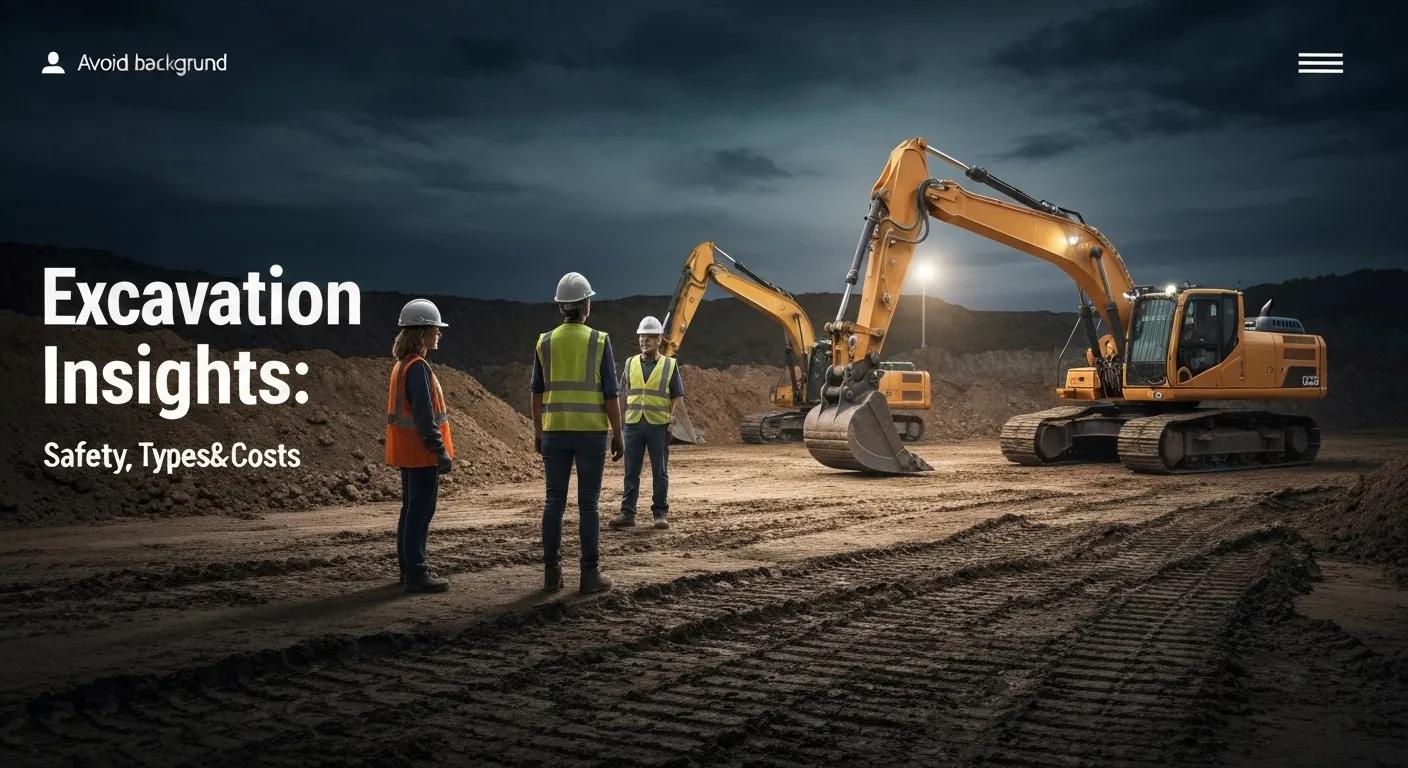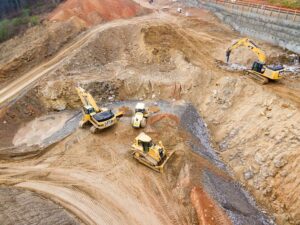
Excavation Insights: Safety, Types & Costs
Excavation underpins every successful construction project, yet uncertainties about safety measures, methods and pricing can stall progress and inflate budgets. This guide addresses the most common questions contractors and project managers face, offering clear definitions, step-by-step processes and practical examples. You will discover essential safety guidelines, distinctions among excavation types, cost drivers and pricing benchmarks, cutting-edge equipment and techniques, the foundation excavation workflow, integration with civil works and local Kentucky regulations. While Earth Works, LLC specializes in precision excavation, grading and utility installation across Kentucky, this article focuses primarily on expert insights before illustrating how their services ensure seamless groundwork and robust foundations.
What Are the Key Excavation Safety Guidelines to Follow?
Effective excavation safety combines hazard identification, preventive methods and continuous oversight. Excavation requires safety measures to protect workers and assets by preventing collapses, utility strikes and falls. Implementing systematic inspections and documented risk assessments helps maintain secure trenches and open‐cut sites. These guidelines minimize downtime and ensure uninterrupted progress on residential, commercial or infrastructure projects.
Routine safety audits establish a reliable compliance framework and strengthen on-site discipline. Consistent training on emergency response and confined-space protocols fosters a safety-first culture. Understanding the next step—recognizing excavation hazards—creates the foundation for targeted preventive strategies.
What Are the Main Hazards Associated with Excavation Work?
Excavation hazards include cave-ins, falling loads and contact with buried utilities, each posing severe risks that demand proactive controls.
- Cave-ins can entrap workers, so sloping or benching the trench sides is crucial.
- Falling loads from machinery or unsecured materials require exclusion zones and overhead protection.
- Striking underground utilities can cause fires or service interruptions, calling for precise locating techniques.
These hazards guide the design of supportive measures such as benching, shoring and shielding, leading us to explore how to detect and avoid buried infrastructure.
How Can Underground Utilities Be Safely Detected and Avoided?
Locating underground utilities combines electronic detection, site records and careful test-pitting to prevent damaging gas, water or electrical lines. This process reduces strike incidents and costly repairs by ensuring accuracy before excavation begins.
- Use electromagnetic locators and ground-penetrating radar to map subsurface lines.
- Consult utility maps and coordinate with local providers for confirmation of buried services.
- Perform soft-dig test holes to validate electronic findings and adjust excavation plans.
Accurate utility detection supports safer digging practices and prepares the ground for the selection of appropriate personal protective equipment.
What Personal Protective Equipment (PPE) Is Required for Excavation?
PPE for excavation protects workers from physical, chemical and atmospheric hazards, improving on-site safety and compliance. Standard equipment includes hard hats for impact protection, high-visibility vests for machine awareness, steel-toe boots for foot safety and respiratory masks when dust or vapors are present. Gloves and eye protection guard against sharp edges and flying debris. Ensuring correct PPE selection and fit reduces injury rates and enhances worker confidence, paving the way to understanding Kentucky-specific regulations.
What Are the Kentucky-Specific Excavation Safety Regulations?
Kentucky regulations mandate regular inspections by a competent person, protective systems for trenches deeper than 1.2 meters and clear access points for every 7.5 meters of trench length. These rules align with federal standards while emphasizing local permit requirements and reporting procedures. Employers must document soil classifications and support system designs. Compliance ensures legal adherence and sets the stage for advanced protective methods like trench shoring.
How Does Trench Shoring Prevent Excavation Accidents?
Trench shoring employs steel plates, hydraulic shores or trench boxes to support sidewalls and prevent collapses. This technique directly counters earth pressure and minimizes cave-in risk by stabilizing loose soil. By installing shoring before personnel entry, contractors maintain secure trenches and uninterrupted schedules. Understanding this method leads into the diverse types of excavation suited to different project goals.
What Are the Different Types of Excavation Work and Their Uses?
Excavation work encompasses specific methods tailored to project requirements, from precise foundation digging to expansive mass earthwork. Recognizing each type’s purpose, mechanism and expected outcome helps contractors choose efficient solutions and allocate resources effectively. Earth Works, LLC offers the full spectrum of services—from trench excavation for utilities to demolition excavation for site clearance—ensuring each application meets structural and budgetary demands.
What Is Foundation Excavation and Why Is It Important?
Foundation excavation prepares stable trenches and pads for building footings by removing unsuitable material and reaching load-bearing strata. Accurate excavation prevents settlement issues, water ingress and structural failures. For example, thorough soil assessment and precise digging enable concrete footings to bear the intended loads without shifting. This critical service supports project longevity and transitions naturally into large-scale earthmoving contexts.
When Is Mass Earthwork Required in Construction Projects?
Mass earthwork involves moving vast volumes of soil to reshape land for roads, embankments or building platforms. Heavy machinery and GPS-guided grading ensure accurate terrain modifications. Contractors use mass earthwork when topography must be adjusted to achieve drainage gradients or create building pads. Understanding these large-scale operations lays the groundwork for discussing utility trenching benefits.
How Is Utility Trenching Performed and What Are Its Benefits?
Utility trenching combines targeted excavation with conduit installation to embed electrical, water or communication lines. Precision trenching minimizes ground disturbance and ensures proper slope for drainage. Backhoes and trench boxes maintain wall stability, while tracer wire and warning tape enhance future locatability. This method reduces repair costs, protects infrastructure and streamlines service integration.
What Are the Differences Between Trench, Basement, and Grading Excavation?
These distinctions inform equipment choice and safety measures and prepare the transition to demolition excavation’s role in civil works.
How Does Demolition Excavation Fit into Civil Works?
Demolition excavation clears structures and debris to prepare sites for redevelopment or utility upgrades. It integrates heavy-duty breakers, excavators with shear attachments and debris screening to salvage reusable material. By combining demolition and earthmoving, contractors optimize timelines and reduce waste, highlighting the synergy between excavation and broader civil works initiatives.
Excavation FAQs: Safety Guidelines, Types, Costs & Processes
Excavation pricing reflects project scale, complexity and site conditions, influencing budget forecasts and client expectations. Cost estimates require detailed soil analysis, access evaluation and equipment planning. Transparent pricing builds trust and positions contractors like Earth Works, LLC as reliable partners for accurate quotes and seamless budgeting.
What Are the Main Factors Influencing Excavation Project Costs?
Several elements drive excavation costs, including:
- Project size and depth, dictating volume of material removed.
- Soil type and stability, affecting excavation speed and support systems.
- Site access constraints, determining logistics and labor intensity.
- Equipment selection and fuel prices, shaping operational expenses.
These factors interrelate—denser soils increase machinery wear, elevating fuel consumption and labor hours—leading us to examine soil type impact.
How Does Soil Type Impact Excavation Pricing?
Soil characteristics such as clay content, moisture level and rock presence influence excavation rates. Soft soils allow rapid digging but may require extensive shoring, while rocky strata slow progress and increase tool wear. Sandy conditions demand erosion control measures, adding erosion-prevention costs. Accurate soil classification ensures realistic budgets and informed contractor quotes.
What Are Typical Cost Ranges for Foundation and Trenching Excavation?
These values guide preliminary budgeting and lead naturally into the quote-generation process.
How Can Clients Get Accurate Excavation Quotes from Contractors?
- Schedule on-site assessments with a qualified estimator.
- Provide plans and utility maps for scope clarity.
- Request breakdowns of labor, equipment and material screening costs.
Transparent quotes reduce unexpected expenses and prepare the ground for understanding related site-preparation charges.
What Costs Are Associated with Site Preparation and Earthmoving?
Site preparation includes tree removal, grading and erosion control, each adding distinct cost elements:
- Vegetation clearance and stump grinding.
- Temporary drainage installations and sediment traps.
- On-site screening or off-haul of surplus material.
Comprehensive budgeting for these tasks ensures clients avoid scope creep and maintain project schedules.
What Equipment and Techniques Are Used in Modern Excavation Projects?
Modern excavation employs advanced machinery and specialized methods to improve efficiency, precision and safety. Contractors balance equipment capabilities with site demands, selecting the right tools for soil conditions and project scale. Understanding equipment roles clarifies technique selection and process coordination.
What Are the Roles of Excavators, Backhoes, and Bulldozers?
Excavators deliver deep digging power with hydraulic arms and bucket attachments, ideal for foundation pads and trenching. Backhoes combine loader and digger functions for versatile site work and small-scale trenching. Bulldozers push large soil volumes for rough grading and mass earthwork. Each machine optimizes specific tasks, streamlining workflow and reducing cycle times.
How Does Vacuum Excavation Work and When Is It Used?
Vacuum excavation uses high-pressure air or water to loosen soil and a powerful suction hose to remove debris without damaging utilities. This non-destructive method excels near buried pipelines or sensitive environments. It minimizes utility strikes, accelerates potholing and supports precise excavation around existing services.
What Are the Best Digging Techniques for Different Soil Types?
- Cohesive clays require controlled shoring or trench boxes to prevent wall collapse.
- Sandy soils benefit from sloping benches and sediment control measures.
- Rock layers often need hydraulic breakers or blasting in calibrated sections.
Matching methods to soil profiles preserves equipment life and accelerates site preparation.
How Is Site Preparation Conducted Before Excavation Begins?
Site preparation comprises clearing vegetation, installing erosion controls and establishing access routes. Contractors grade the terrain to specified levels, construct temporary roads and set up sediment fences or silt traps. Proper preparation prevents water accumulation in trenches, protects adjacent land and primes the site for efficient excavation.
What Are the Essential Steps in the Foundation Excavation Process?
Foundation excavation follows a structured sequence to guarantee structural integrity and regulatory compliance. Breaking this workflow into stages ensures systematic execution and predictable timelines.
How Is a Site Assessed and Prepared for Foundation Excavation?
Site assessment involves topographic surveys, soil sampling and utility mapping to inform excavation depth and support requirements. Preparing the site includes clearing debris, laying out footings and installing perimeter controls. These preparatory actions reduce unexpected conditions during digging.
What Safety Measures Are Taken During Foundation Digging?
During foundation digging, contractors enforce exclusion zones around heavy equipment, conduct daily inspections of trench walls and maintain clear egress points. Protective systems like trench boxes or hydraulic shores guard workers against cave-ins and promote a reliable working environment.
How Is Excavated Material Managed and Screened Onsite?
Excavated material is segregated by soil type and screened for reuse in backfill or grading, minimizing waste disposal costs. Material screening plants on-site process fines and remove debris, ensuring that clean fill meets compaction and drainage specifications.
What Are the Typical Project Timelines for Foundation Excavation?
Foundation excavation timelines range from one to three weeks, depending on soil conditions, weather and project complexity. Initial assessment and preparation require two to four days, digging takes three to seven days, and backfill and compaction extend over an additional two to six days. Predictable schedules support seamless handover to concrete works.
How Does Excavation Integrate with Civil Works and Infrastructure Projects?
Excavation is the bedrock of civil engineering, enabling road construction, drainage installation and land development. By aligning earthmoving with infrastructure requirements, contractors ensure functional longevity and regulatory compliance.
What Role Does Excavation Play in Road Construction and Land Development?
Road construction begins with subgrade excavation to remove unsuitable fill and achieve designed pavement profiles. Precise cutting and compaction establish a stable base for asphalt or concrete layers. In land development, mass grading shapes sites for utilities and stormwater management, setting conditions for sustainable growth.
How Are Drainage Systems Installed During Excavation?
Drainage installation involves trenching for perforated pipes, creating shoulder slopes and embedding geotextile fabrics. Excavation crews coordinate with civil engineers to establish fall gradients and ensure proper runoff management, preventing water-related damage to structures and roadways.
What Are the Phases of Civil Engineering Projects Involving Excavation?
Civil projects proceed through planning, site investigation, rough excavation, utility installation, fine grading and final compaction. Each phase demands specific equipment and quality checks to align with engineering designs. Collaborative sequencing between excavation crews and engineers reduces rework and enhances project efficiency.
How Do Contractors Manage Erosion Control During Excavation?
Erosion control combines sediment fences, silt basins and temporary vegetation covers to prevent soil loss and protect waterways. Contractors implement phased excavation to minimize exposed areas and restore disturbed zones quickly. This approach safeguards the environment and supports regulatory compliance.
What Are the Local Permits and Regulations for Excavation in Kentucky?
Navigating Kentucky’s permitting framework ensures legal excavation and uninterrupted project timelines. Familiarity with local requirements avoids fines and delays, reinforcing trust and authority in civil works undertakings.
What Excavation Permits Are Required in Kentucky?
Kentucky mandates an excavation permit for projects exceeding specified depths or involving public right-of-way work. Permit applications require site plans, soil reports and support system designs. Early submission accelerates approval and aligns schedules with regulatory cycles.
How Are Underground Utilities Located and Marked Before Digging?
Before digging, locate buried lines using electromagnetic detection and verify with hand-dug test holes. Marked utilities employ color-coded flags and paint to denote different services. Clear marking protocols prevent utility damage and ensure worker safety at every excavation stage.
What Are the Kentucky Trenching and Shoring Regulations?
State regulations require protective systems for trenches deeper than 1.2 meters and daily inspections by a competent person. Designs must follow tabulated data for soil types, sloping angles or benching requirements. Adherence to these rules minimizes collapse risk and maintains compliance.
How Do Local Safety Standards Align with OSHA Requirements?
Kentucky excavation standards mirror federal OSHA regulations on protective systems, inspections and training, while specifying local permit processes and soil classification protocols. This alignment ensures consistent safety levels and a unified regulatory approach for contractors working region-wide.
Before Earth Works, LLC mobilizes equipment, it confirms full compliance with all state and federal requirements, delivering reassurance and uninterrupted project progress.


